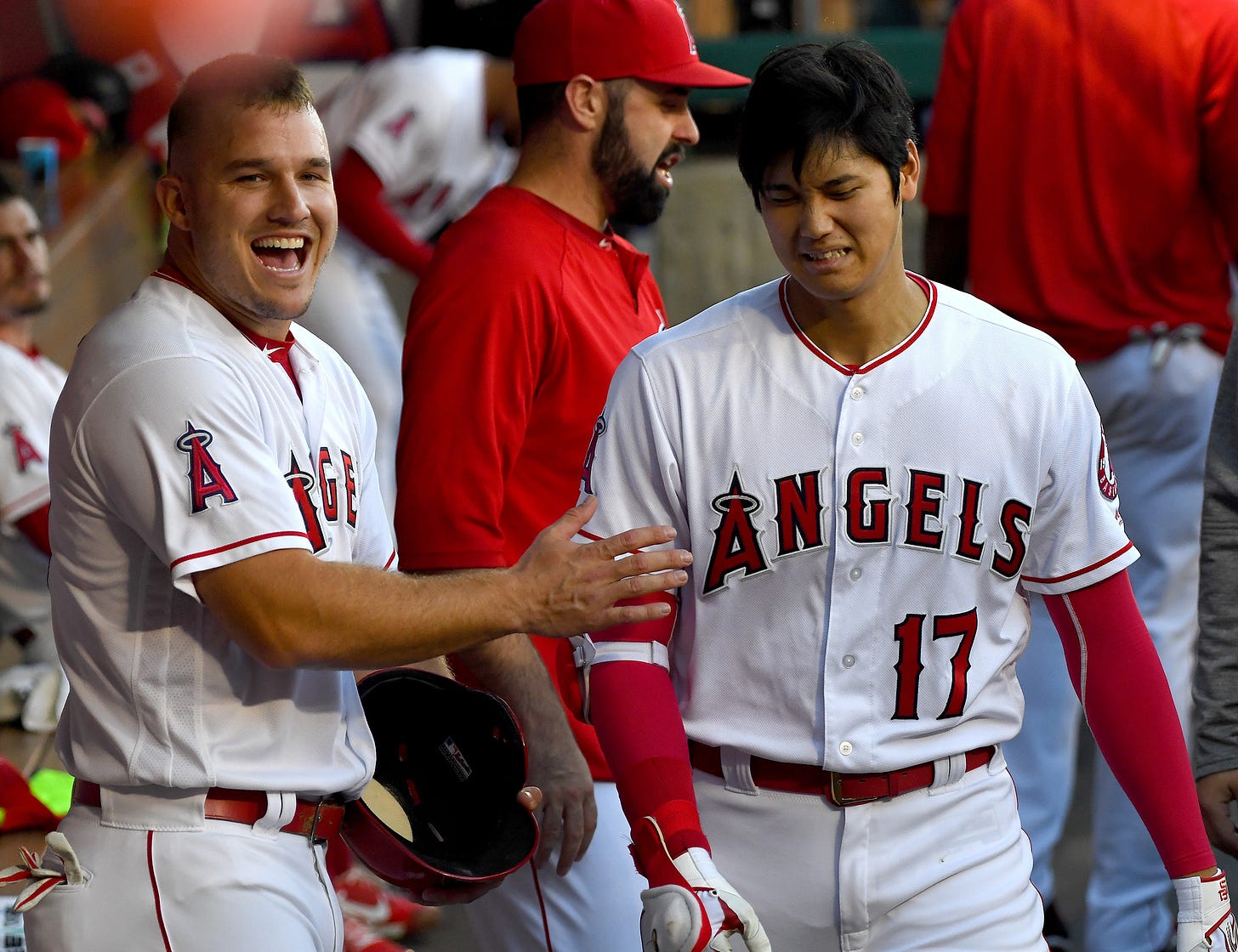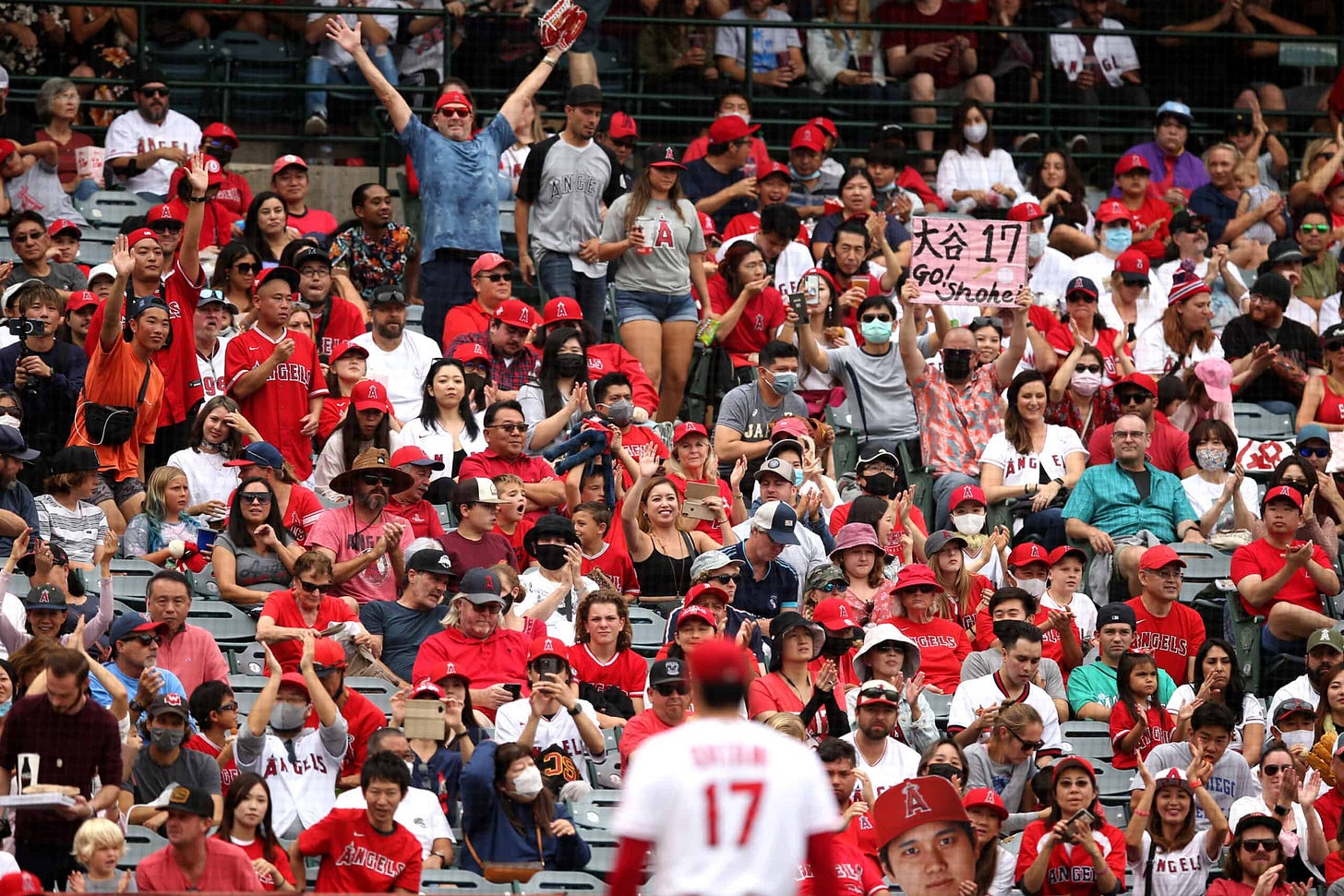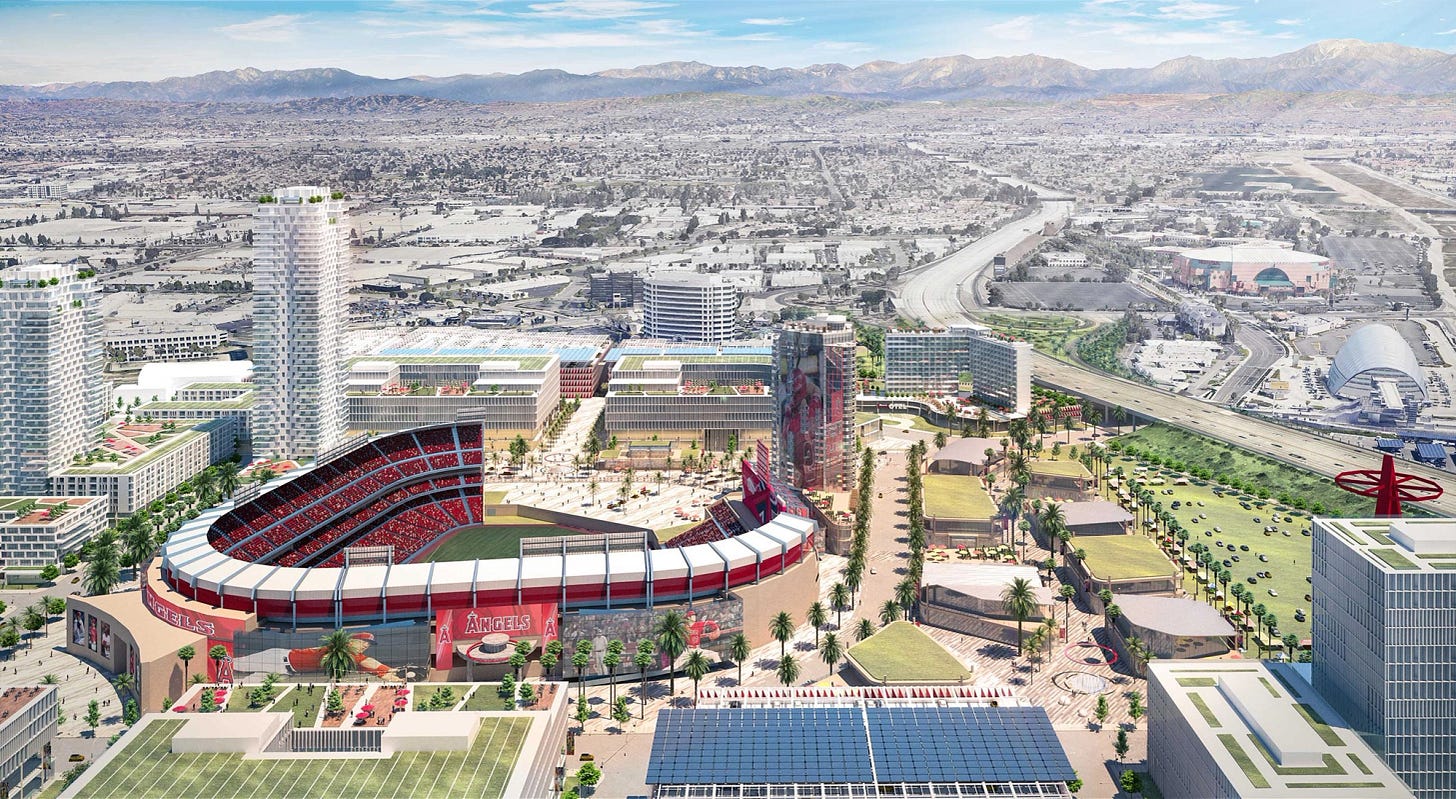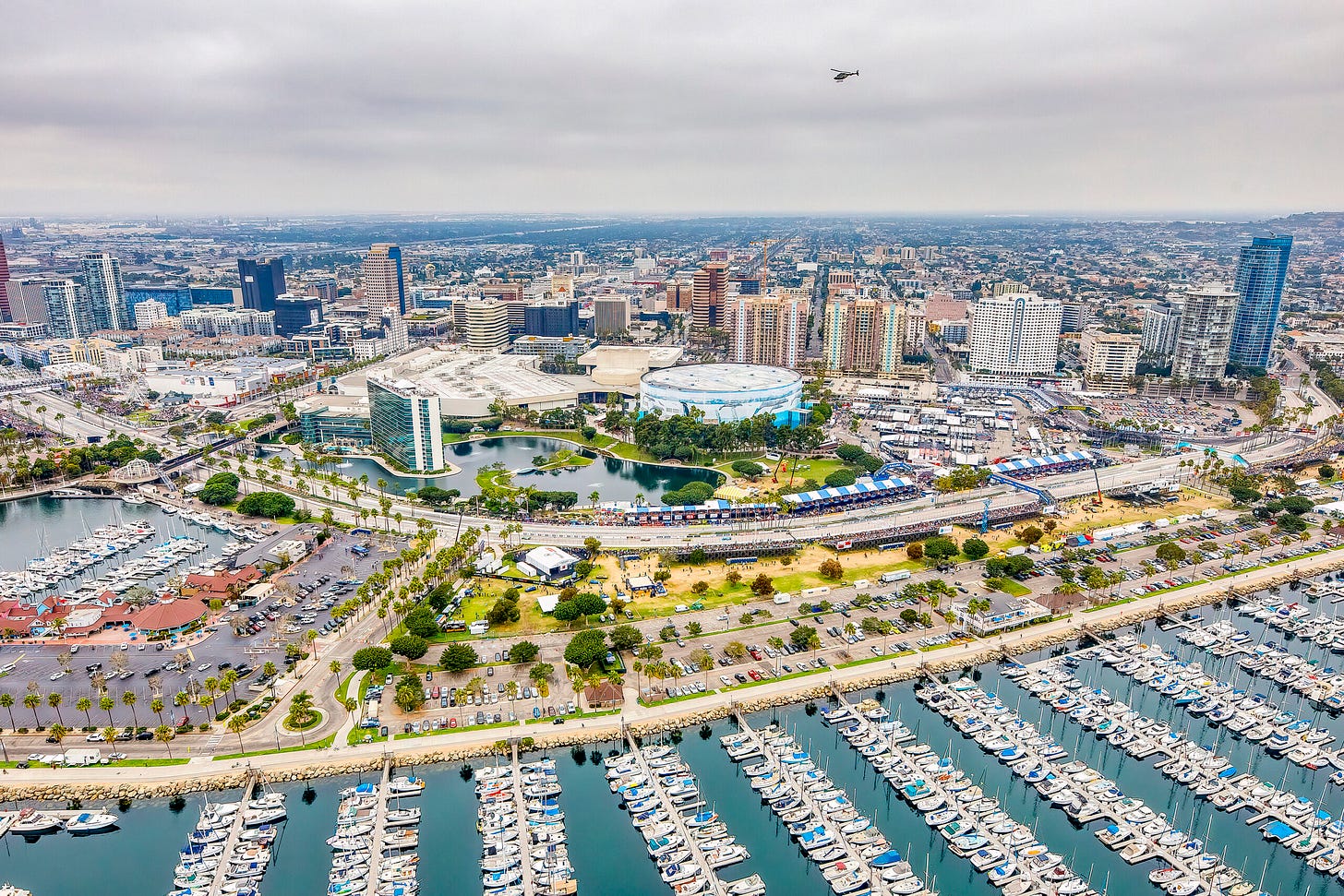The California Angels
The state should use its surplus money to buy a very popular and profitable organization that happens to field a baseball team with two generational talents
Something has to be done about the Los Angeles Angels of Anaheim, the most disappointing franchise of the past decade in Major League Baseball. Their ownership group shows no interest in winning, and now they’re holding the city hostage as they negotiate a new taxpayer subsidy to redevelop the stadium’s massive parking lots into housing and other amenities. The situation has devolved into a corruption scandal that’s reaching all corners of Southern California politics as the FBI investigates city officials close to the negotiations, and any redevelopment of the site is hung up in the bureaucracy. Now the team, the stadium, and the city of Anaheim are the focus of national attention for all the wrong reasons. What went wrong?

Let’s start on the field: In 2011 they signed Albert Pujols to a MLB-record 10-year, $254 million contract at age 32, a contract they were still paying while he was playing for the cross-town rival Dodgers last year. That contract, in the 10 years that followed, seems to have cursed the Angels to languish in mediocrity even with three of the best players in a generation on their team.
The same year Pujols debuted for the Angels, another phenom made his first appearance in the league. A young Michael Nelson Trout, drafted 25th overall in 2009, appeared in 40 games in 2011 before his first full season in 2012. Since then, Trout’s racked up 1400 hits, 320 home runs, three MVP awards, nine All-Star appearances, eight Silver Slugger awards, a career batting average over .300, and he’s the current active leader in OBP, SLG%, and OPS. Quite simply, he’s the best player in baseball since Pujols, who had 1700 hits, 400 home runs, nine All-Star appearances, three MVP awards, and two World Series rings in his first 10 seasons. Pujols wasn’t the same on the back end, though, hitting only .256 with a .758 OPS in 10 years in Anaheim.
Then, to top it all off, the Angels were the lucky chosen ones when the most interesting international free agent of all time came to America: at the age of 21 in Japan, Shohei Otani hit .322 with 22 home runs and an OPS of 1.004 – and started 22 games on the mound, giving up just 89 hits in 140 innings with an ERA of 1.86. That’s world class as a hitter and a pitcher, and soon he would become the first two-way player to break into the majors since Babe-fuckin-Ruth. He won rookie of the year in 2018 and MVP in 2021, a year he hit 46 home runs and had 156 strikeouts in 130 innings. Even doing one of those would make him a star, but he’s out here doing both at the highest level.
But what do the Angels have to show for it? In the 10 years of Trout, they’ve made the playoffs exactly one time, and lost all three games to get swept out by the Kansas City Royals. They’ve been under .500 the last six years, and though they’re off to a hot start this year, history tells me sometime around July the losses will start racking up before their inevitable slide to fourth place and a seat on the couch for the Fall Classic. As it turns out, having the two best players in the league on your team isn’t enough over 162 games; baseball, more than any sport, is a team effort that rarely swings on the bat of a single star (or even two).
You’d think a professional baseball general manager would understand this; you’d think that, with the two brightest young stars in the game on their roster, the organization would be eager to win, and go the extra mile to do so. In professional sports, that means the extra 10 or 20 million on the payroll to fill out your lineup with solid hitters and a bullpen. Yet only in 2018 did the team break $200M in player salaries, while they’ve been over $300M in revenue since 2014. I don’t want to act like the Angels are the only team doing this; while revenues have grown by millions of dollars, MLB player salaries have flatlined. While a few players earn massive amounts of money, the median salary in Major League Baseball went down by half a million dollars since 2015.
What does all this mean? Well, the Angels are the perfect example of a new style of organizational management: They signed a couple of big stars to put butts in seats at the stadium, and filled out the rest of the roster with the cheapest players they could find. The extra payout from the playoffs (TV contracts, extra-expensive tickets) is a big incentive to win, but apparently not enough when you can go 77-85 without much of a drop in revenues. Despite their string of losing seasons, the Angels were fifth in revenue in 2020 and ninth in franchise value after the 2021 season. Why would they spend more money if it’s not necessary to make money?
If you couldn’t tell, this is bad for baseball. It’s bad that teams within striking distance are choosing not to compete; it’s bad that the owners’ collective disincentive to spend is limiting salaries for everyday players; and it's especially bad that the two best players in baseball haven’t been to the postseason, when the most eyes are on the game. If MLB wants to grow the game, something they constantly preach, they need to get their stars on the biggest stage. I have some ideas for the league, starting with significantly raising the luxury tax threshold, but the specific problem of the Angels wasting two once-in-a-lifetime talents isn’t as easy to solve.
And, on top of all that, the Angels are now the center of a political corruption scandal that has upended the sale of the stadium and its grounds to the team, while the mayor of Anaheim has resigned pending an FBI investigation into allegations he leveraged the deal to secure campaign contributions. Last week, the former CEO of the city’s chamber of commerce was charged with making false statements to a financial institution, and he is accused of diverting funds from the chamber to his own bank account.
In the mess, Angels owner Arte Moreno demanded the city approve the deal, while the state housing agency warned the council against it; HCD told the city the land has to be offered to affordable housing developers before any sale to the team, based on the 2019 Surplus Land Act. In May the city council voted to cancel the sale, a decision Moreno isn’t contesting, because their current lease on the stadium extends until 2029, with control over development on the property; the organization could simply not buy the site, play out their lease, and leave the city of Anaheim hanging a decade later.
This puts the city in a tough spot; they wanted to entice the Angels to buy the property contingent on affordable development, because the other option is sit on a 153-acre parking lot and wait until the lease ends. But they also don’t want to give the team too much of a discount on a property possibly valued at $500 million, and still wait 30 years for any housing units to open. All of that just to keep the constantly-losing Angels in Anaheim at the fourth oldest (and arguably the most car-dependent, but that’s a different issue) stadium in the bigs. But what else can they do?
Enter the state of California. Governor Gavin Newsom recently announced a budget surplus close to $100 billion, almost half of which is reserved for one-time spending. The Angels’ team valuation is roughly $2.5 billion and in 2019 they brought in over $60 million in profits before the pandemic shuttered stadiums for a year and revenues fell dramatically. With our surplus, the state could easily afford the price and as long as fans are filling out the stadium, they’d make money every year on the deal, money that could be invested back in the team instead of lining an owner’s pockets.
And if they bought the team, the state and a city could share control of it, their stadium, and the land it sits on, and put all three to better use without dealing with the profit incentives that go along with private ownership. As a state enterprise, the people would have a say in team operations, albeit indirectly. Just like the owners now, city and/or state leaders would be tasked with hiring a general manager who’d run the organization. But that also means we’d have some power to tell elected officials what we want for the team. If they’re not winning, it could be time to make changes.
It’s not like this is unprecedented; several minor-league teams have some form of municipal ownership, and the most famous example is the Green Bay Packers, who’ve been owned by a community non-profit organization since incorporation in 1923. 360,548 stockholders own shares in the company, who vote on the team’s board of directors and a seven-member executive committee. This hasn’t only worked to build a historic franchise, with fifteen winning seasons in the last 20, including a 2011 Super Bowl win; it’s kept the Packers in Green Bay for a century and created the most loyal fanbase in the NFL. On Thursday Lou Correa, Anaheim’s Representative in the House (no relation to Carlos Correa, Twins Shortstop), even suggested the city buy the team, referencing the Green Bay Packers as a model. But while the city deals with the problems we discussed above, the state is in a great place to make an impulse buy that could possibly change professional sports.
This doesn’t mean the idea isn’t without hurdles; MLB owners have worked tirelessly to ensure teams aren’t municipally owned, probably because letting one domino fall would set a precedent that would limit their ability to extract profit from the league. Plus, If cities start pushing for ownership stakes in their teams, it could jeopardize the incredibly lucrative stadium deals local governments are forced to sign to keep their team around. Miami spent more than $800 million on the new Marlins’ stadium back in 2009 when the entire franchise was valued at just $277 million; The Washington Nationals just received about $700 million in taxpayer money for their new stadium in DC after the team itself was sold for $450 million. If the city owned the team, that investment would make a lot more sense, but if one team does it, many others will start to question how much of a subsidy they should shell out without any return on their investment.
But, if they choose to exercise it, the state has a lot more power than the owners. This stadium debacle has opened the door for state intervention; the city council has already denied the sale of the property on the previous terms and could shop it to other buyers, like the state. If the state owns the property, they could threaten to evict the Angels. California could even go nuclear and use eminent domain to seize the property and put it to better use, unless the owners let the state buy the team. At that point Major League Baseball and the owners would be forced to either lose a team in the nation’s most lucrative media market or accept municipal ownership. They’d be stuck – there isn’t a west coast city outside California that could support a team but doesn’t already have one. Vegas is the likely landing spot for the Oakland A’s, and Salt Lake City and Portland have NBA teams, but it’s one thing to fill the 19,000 seats at the Moda Center, quite another to bring out 40,000 and fill a baseball stadium. Buy the property and offer to buy the team, and tell MLB: you want to have a team in our state? You gotta play ball (pun intended).
The state should use a small portion of its surplus money to buy a very popular and profitable organization that happens to field a baseball team with two generational talents, and turn it into the locally owned California Angels. Offer Mr. Moreno a lucrative buyout, dare the owners to reject the sale, and be ready to go to court if they call your bet. I have a feeling Major League Baseball wants to keep the state with the most teams happy, and clearly Arte’s ownership style hasn’t led to many postseason appearances for his bright young stars. Plus, everybody loves the throwback uniforms they still wear from time to time, so why not just use those permanently? And, if they really want to switch things up, they could build a new, transit-oriented downtown waterfront stadium in a bigger, better city than Anaheim – Long Beach, of course.







